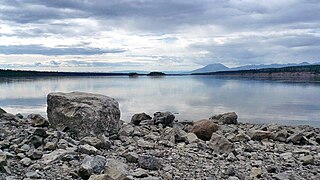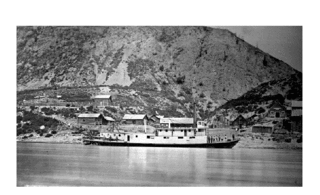
The Liard River flows through Yukon, British Columbia and the Northwest Territories, Canada. Rising in the Saint Cyr Range of the Pelly Mountains in southeastern Yukon, it flows 1,115 kilometres (693 mi) southeast through British Columbia, marking the northern end of the Rocky Mountains and then curving northeast back into Yukon and Northwest Territories, draining into the Mackenzie River at Fort Simpson, Northwest Territories. The river drains approximately 277,100 square kilometres (107,000 sq mi) of boreal forest and muskeg.
Telegraph Creek is a small community located off Highway 37 in Northern British Columbia at the confluence of the Stikine River and Telegraph Creek. The only permanent settlement on the Stikine River, it is home to approximately 250 members of Tahltan First Nation and non-native residents. The town offers basic services, including Anglican and Catholic churches, a general store, a post office, a clinic with several nurses on-call around the clock, two Royal Canadian Mounted Police officers, and a k-9 school. Steep river banks and rocky gorges form the terraced nature of the geography.
The Liard River First Nation, also known as the Liard First Nation is a First Nation in the southeastern Yukon in Canada. Its main centres are Upper Liard and Watson Lake along the Alaska Highway. The language originally spoken by the people of this First Nation was Kaska and the First Nation is a member of the Kaska Tribal Council which is pursuing land claims in the Yukon and northern British Columbia. Their Indian and Northern Affairs Canada band number is 502.

The Fraser Canyon Gold Rush, began in 1857 after gold was discovered on the Thompson River in British Columbia at its confluence with the Nicoamen River a few miles upstream from the Thompson's confluence with the Fraser River at present-day Lytton. The rush overtook the region around the discovery, and was centered on the Fraser Canyon from around Hope and Yale to Pavilion and Fountain, just north of Lillooet.

The Dease River flows through northwestern British Columbia, Canada and is a tributary of the Liard River. The river descends from Dease Lake, though its ultimate origin is in the headwaters of Little Dease Creek at Snow Peak, approximately 50 kilometres (31 mi) west of the lake. The river flows 265 kilometres (165 mi) generally north-eastward, draining into the Liard River near Lower Post, British Columbia. Large sections of the river parallel the Cassiar Highway, helping to make it a popular destination for canoeists, kayaakers, and rafters.

Emory Creek Provincial Park is a provincial park in British Columbia, Canada, located on the west side of the Fraser River just south of the town of Yale. It commemorates the location of a large boomtown, variously known as Emory, Emory Bar or Emory City, that first rose during the Fraser Canyon Gold Rush but became a major construction town during the building of the Canadian Pacific Railway in the 1880s.
Emory Creek in 1858 was a tent and shack camp, established by miners in search of gold. When it became evident that the gold was not available in the amounts estimated, the miners started moving north on the Fraser River. A few Chinese remained in the area. The area came into the hands of a man named Walker, who felt Emory Creek would become the head of riverboat navigation on the Fraser. Eventually, he sold the land to the Oppenheimer Brothers in early 1879. In the fall of 1879, Emory was chosen by the C.P.R. as the western terminus. In a short time it became Emory Creek. The town consisted of thirteen streets with its own newspaper, various shops, a brewery, nine saloons and a sawmill. When Yale was made the terminus, Emory was all but abandoned by 1885, with the completion of the railway. Today, it is an easily accessible treed campground with paved roads and flush outhouses.
Todagin South Slope Provincial Park is a provincial park in British Columbia, Canada, located on the west side of Todagin Creek to the east of Kinaskan Lake in the Stikine Country, to the south of the community of Dease Lake. Created in 2001, it contains c. 3557 ha.

The Stikine Country, also referred to as the Stikine District or simply "the Stikine", is one of the historical geographic regions of the Canadian province of British Columbia, located inland from the central Alaska Panhandle and comprising the basin of the Stikine River and its tributaries. The term Stikine–Iskut is also fairly common to describe the area, and references the Iskut River, the Stikine's largest tributary and describable as its south fork.

The Cassiar Country, also referred to simply as the Cassiar, is a historical geographic region of the Canadian province of British Columbia. The Cassiar is located in the northwest portion of British Columbia, just to the northeast of the Stikine Country, while to the south is the Omineca Country. The area is noted for the Cassiar gold rush of the 1870s, when Laketon became its unofficial capital. The ghost town of Cassiar is also located in the Cassiar region.

Fairview is a ghost town in British Columbia on the west side of the Okanagan River between Cawston and Oliver. It is the original townsite for what is now the town of Oliver, famous for the Fairview Hotel that burned down in the 1902.

Laketon is a locality and former mining camp on the west shore of Dease Lake in the Cassiar Country of far northern British Columbia, Canada. It is located at the mouth of Dease Creek. Once known for the hanging of two murderers and their bodies buried at the crossroad to serve as a warning to all. Gold was first found on Dease Creek in 1873, with Captain William Moore among the first to stake a claim.

Defot is a locality and former mining boomtown in the Cassiar Country of the Northern Interior of British Columbia, Canada, located west of Mount Defot.

Steamboats operated on the Stikine River in response to gold finds in along that river and in the Cassiar Country of northwestern British Columbia, Canada.
McDame Creek is a creek located in the Cassiar Land District of British Columbia. The creek flows southeast into Dease River and is south of Good Hope Lake. The creek was discovered in 1874 by a prospector named Henry McDame. McDame Creek was mined for gold in the 19th century. A camp called Centreville contained cabins and stores and served as a trading centre for miners working on McDame Creek in the 19th century. In 1877 a 72 ounce solid gold nugget valued at $1,300 was found in McDame Creek. The solid gold nugget was found by a prospector named Al Freeman, it was the largest found in the province. This nugget was found roughly where 1st N. Fork Creek flows into McDame Creek.
Mary Creek is a creek in the Cariboo region of British Columbia. The creek is located in Cottonwood Country which is between Quesnel and Barkerville. Mary Creek is small tributary of John Boyd Creek which flows into the Cottonwood River. Terry Toop discovered gold on Mary Creek in the fall of 1972. The nuggets found were $150 in value, and $2,200 in gold could be found in a single yard of gravel. Bullion in 15 and 20 pound lots was shipped to a refinery in Richmond. Photographs of the nuggets were published in newspapers along the coast. Other miners moved in and staked claims around the area, but the gold was depleted in 1975.

Centreville is a ghost town in the Cassiar Land District of British Columbia, Canada, northwest of the junction of McDame Creek and the Dease River. It contained cabins and stores, and was a trading centre for miners working on McDame Creek in the 1800s.
Thibert Creek is a creek located in the Cassiar Country region of British Columbia. The creek flows into Dease Lake at the north end. Thibert Creek lies on the western side of Dease Lake. The creek was explored in April, 1873 by Henry Thibert and several French Canadians. Thibert was the first placer gold creek discovered in Cassiar. The creek was mined for gold. The official returns from the gold between the years 1874 and 1895 were $1,279,600. The creek was hand mined by Europeans and Chinese. By 1880 the Chinese owned the majority of claims on the creek as gold on the creek started to dwindle. Only a dozen miners worked the creek by 1895. The creek was later hydraulicked.
Defot Creek is a creek located in the Stikine Region of British Columbia. The creek is a tributary of the west fork of the Canyon River. Defot Creek is located north west of Dease Lake. The creek came to prominence when John Defot discovered gold there in 1878. Two hundred miners moved into the region and created a camp called Defot. Defot was mined using wing damming and sluicing. By 1880 fewer than 40 miners remained at the creek as the gold supply dwindled.
Gold Pan Creek is a creek located in the Cassiar Country region of British Columbia. The creek is a tributary of Little Eagle River about 10 miles east of Dease Lake. This creek was discovered in the fall of 1925 by two men named Grady and Ford. Gold was discovered in Gold Pan Creek. By the end of 1925, there were 165 claims staked on the creek. Hand sluices were used to mine the creek.







